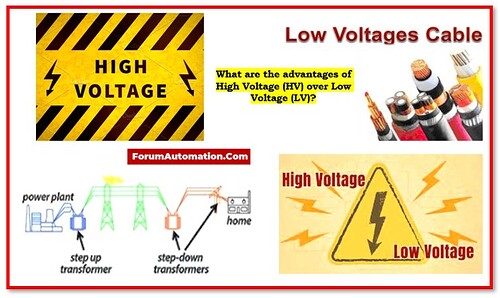Different electrical voltage levels are referred to as high voltage (HV) & low voltage (LV) in power distribution & electrical systems.
Selection between HV and LV is dependent on a number of factors, including the particular application & safety considerations. Each provides a unique combination of benefits and drawbacks.
The following are some benefits of HV over LV:
1). Power losses are Reduced
Lower power losses in electrical transmission & distribution are one of the main benefits of HV. Power losses are proportional to the square of current, or

where
P - Power,
I - Current, &
R – Resistance.
For a given amount of power, users can reduce current (I) by raising voltage (V), which greatly reduces power losses through resistive heating in wires.
2). Compact Conductor Size
To transfer the same amount of power, high-voltage systems can employ smaller conductors (cables or wires) than low-voltage systems. As less material is needed for the conductors, this is more economical.
3). Voltage Regulation
Long-distance voltage maintenance is more appropriate to HV systems. Consumers receive power at a steady voltage because of the minimal voltage loss.
4). Effective Transmission Over Long Distances
HV is perfect for long-distance electrical power transmission. A more efficient and affordable transmission system is created as a consequence of lower power losses, which increase the amount of generated electricity that reaches its destination.
5). Improvements in Grid Stability
HV systems are more durable and can handle changes in electrical demand & supply better. They support grid stability, especially during moments of high demand.
6). Low Current-Related Risks
When opposed to LV systems, HV systems often have lower current ratings for the same amount of electricity. Reduced current can lessen the dangers of electrical shock & fire.
7). Ability to Work with High-Power Equipment
HV is frequently utilized in industrial settings that need for high-power devices like motors and transformers. When used at greater voltages, these devices are efficient and economical.
8). Support for Renewable Energy Sources
Higher voltage power is generated by a number of renewable energy sources, including solar and wind energy. This electricity may be integrated into the grid effectively using HV systems.
9). Environmental Impact is Lessened
HV systems with lower power losses have less of an environmental impact while generating electricity. This is essential when it comes to minimizing greenhouse gas emissions & improving energy effectiveness.
10). Costs of Infrastructure are Lower
Using HV can reduce the cost of building infrastructure. It requires fewer transformers and substations, which are expensive parts of electricity distribution networks. Additionally, there can be less land & right-of-way requirements for HV infrastructure.
